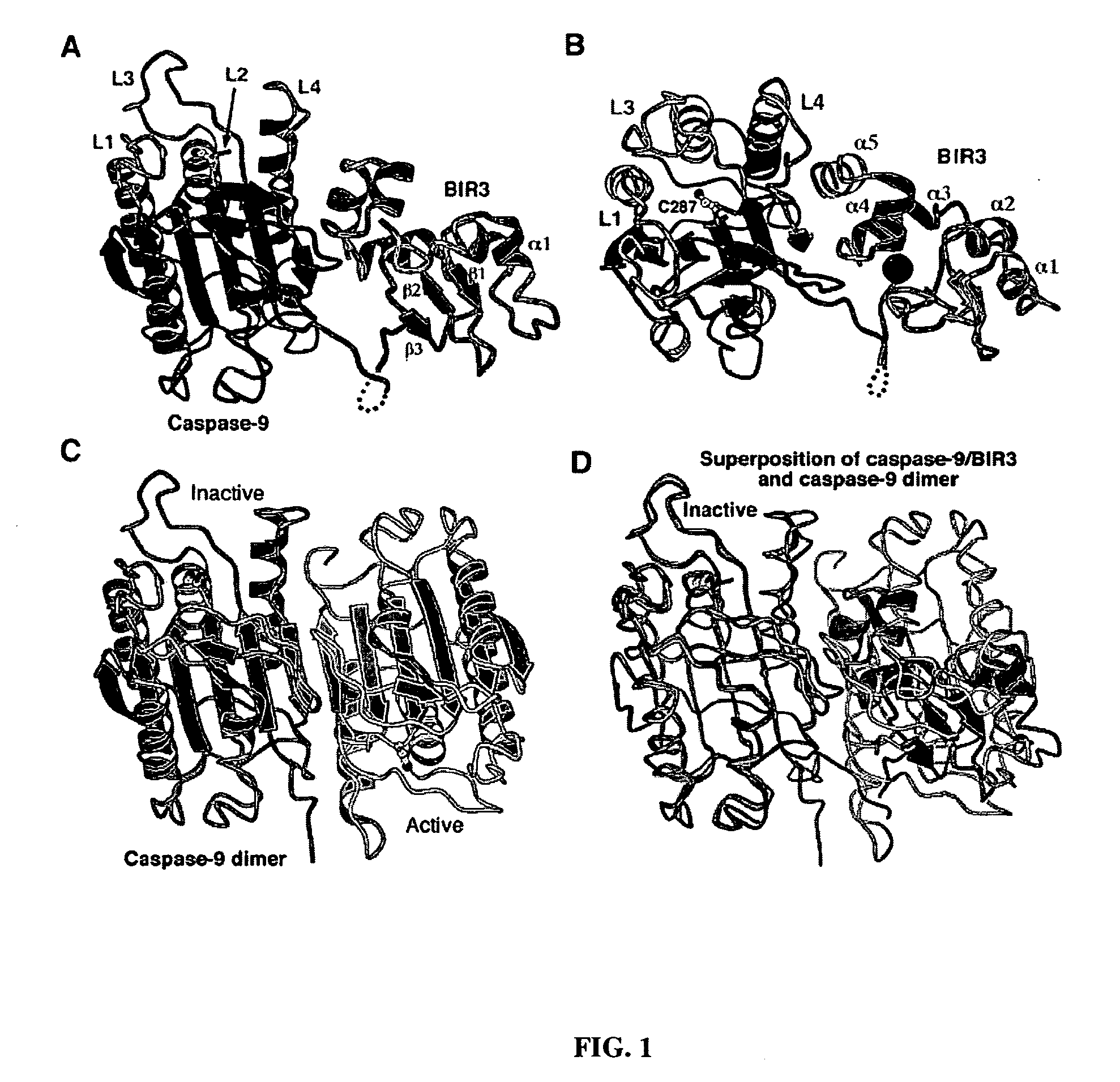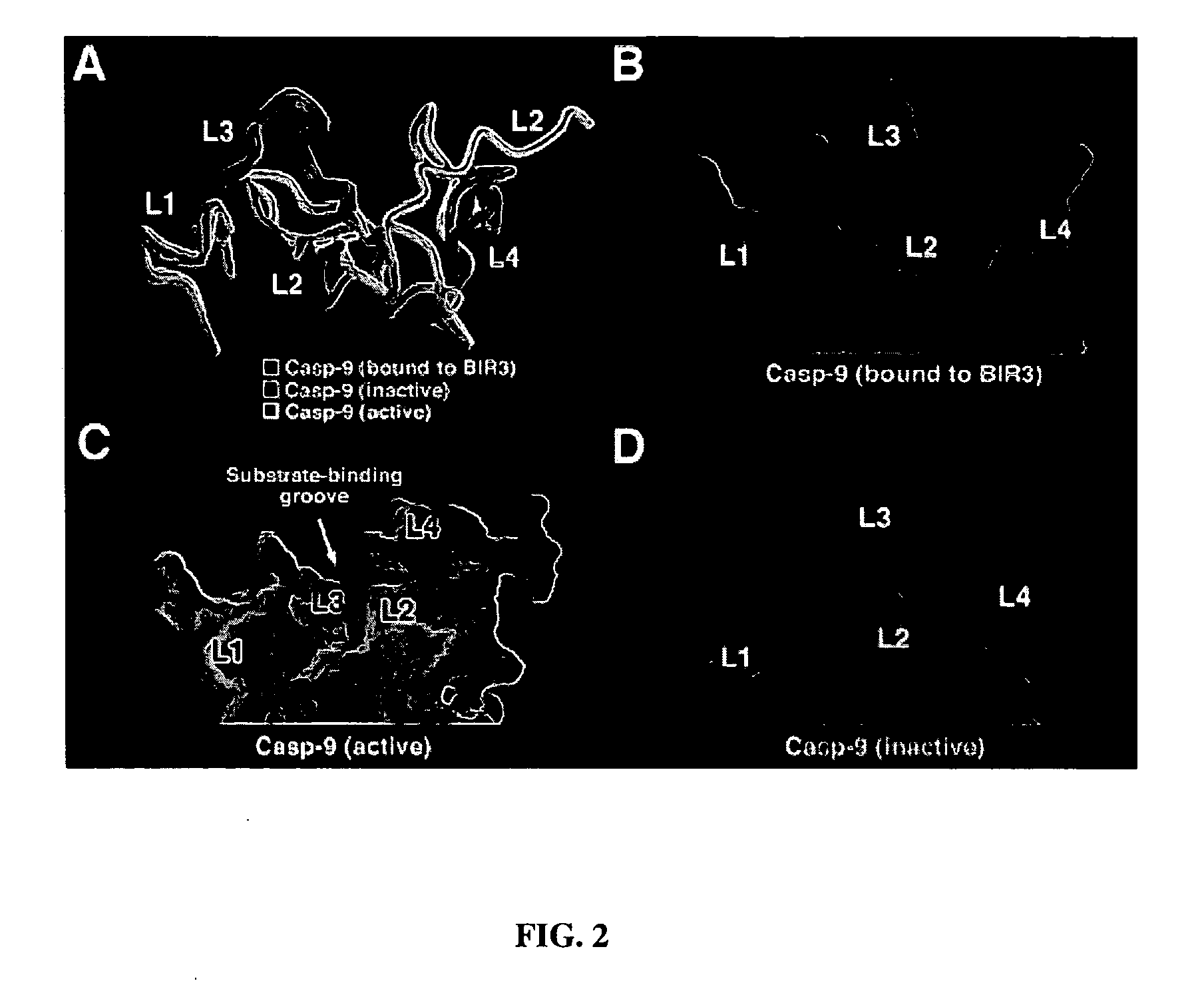Caspase-9 : BIR domain of XIAP complexes and methods of use
a caspase-9 and xiap complex technology, applied in the field of caspase-9 : bir domain of xiap complexes and methods of use, can solve the problems of inability to effectively inhibit the catalytic activity of caspase-9, inability to prevent the catalytic activity, and burying two charged residues in the center of a predominantly hydrophobic interface is energetically extremely unfavorable. , to achieve the effect of potently inhibiting the ca
- Summary
- Abstract
- Description
- Claims
- Application Information
AI Technical Summary
Benefits of technology
Problems solved by technology
Method used
Image
Examples
example 2
[0078] This example describes the structure of inhibiting heterodimer complexes of the present invention. Crystallization and data collection. Crystals of the caspase-9 / BIR3 complex were grown by the hanging-drop vapor diffusion method by mixing protein with an equal volume of reservoir solution. The well buffer contains 100 mM Tris, pH 8.0, 1.0 M potassium monohydrogen phosphate, and 0.2 M sodium chloride. Small crystals appeared after three weeks, with a typical size of 0.1.times.0.1.times.0.3 mm.sup.3. The crystals belong to the space group P6.sub.522, contain one complex in each asymmetric unit, and have a unit cell dimension of a=b=104.42 .ANG. and c=170.31 .ANG.. Crystals were equilibrated in a cryoprotectant buffer containing well buffering plus 24% glycerol, and were flash frozen in a -170.degree. C. nitrogen stream. The native data were collected at the CHESS beamline A1. The data were processed using the software Denzo and Scalepack (Otwinowski and Minor, 1997).
[0079] Stru...
example 3
[0080] This example illustrates the construction of a caspase-9 assay. The reaction was performed at 37.degree. C. under the following buffer conditions: 25 mM HEPES, pH 7.5, 100 mM KCl, and 1 mM dithiothreitol (DTT). The substrate (procaspase-3, C163A) concentration was approximately 80 .mu.M. Caspase-9 variants were diluted to the same concentration (0.3 .mu.M) with the assay buffer. Reactions were stopped with the addition of equi-volume 2.times. SDS loading buffer and boiled for three minutes. The samples were applied to SDS-PAGE and the results were visualized by Coomassie-staining.
example 4
[0081] This example describes the use of analytical ultracetrifugation for measuring the molecular weight of various proteins and polypeptides and its use for determining the presence or absence of inhibitor caspase-9 homo-dimers in solution.
[0082] To accurately determine the basal state of caspase-9 in solution, the molecular weight of caspase-9 was examined by sedimentation equilibrium analysis using analytical ultra-centrifugation (Table 2). Little, if any, variation in molecular weight as a function of rotor speed was observed for any of the caspase-9 samples, indicating that the protein behaves mostly as a single species in solution (data not shown). Both the processed caspase-9 and the unprocessed procaspase-9 zymogen were found to have a molecular weight consistent with that of a monomer. In addition, this analysis confirms that the XIAP-BIR3 domain forms a stable hetero-dimer with the caspase-9 monomer (Table 2). In contrast, this method demonstrates that the active caspases...
PUM
| Property | Measurement | Unit |
|---|---|---|
| Fraction | aaaaa | aaaaa |
| Composition | aaaaa | aaaaa |
| Catalytic activity | aaaaa | aaaaa |
Abstract
Description
Claims
Application Information
 Login to View More
Login to View More - R&D
- Intellectual Property
- Life Sciences
- Materials
- Tech Scout
- Unparalleled Data Quality
- Higher Quality Content
- 60% Fewer Hallucinations
Browse by: Latest US Patents, China's latest patents, Technical Efficacy Thesaurus, Application Domain, Technology Topic, Popular Technical Reports.
© 2025 PatSnap. All rights reserved.Legal|Privacy policy|Modern Slavery Act Transparency Statement|Sitemap|About US| Contact US: help@patsnap.com



